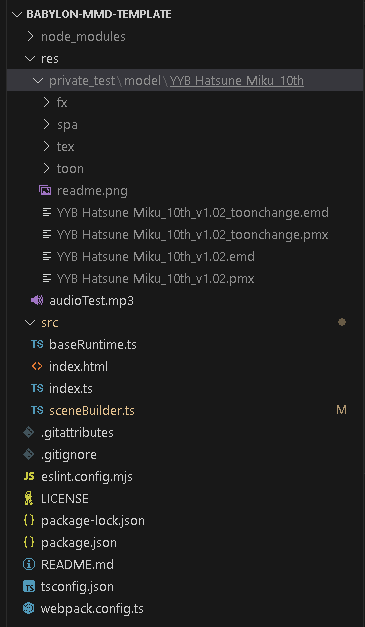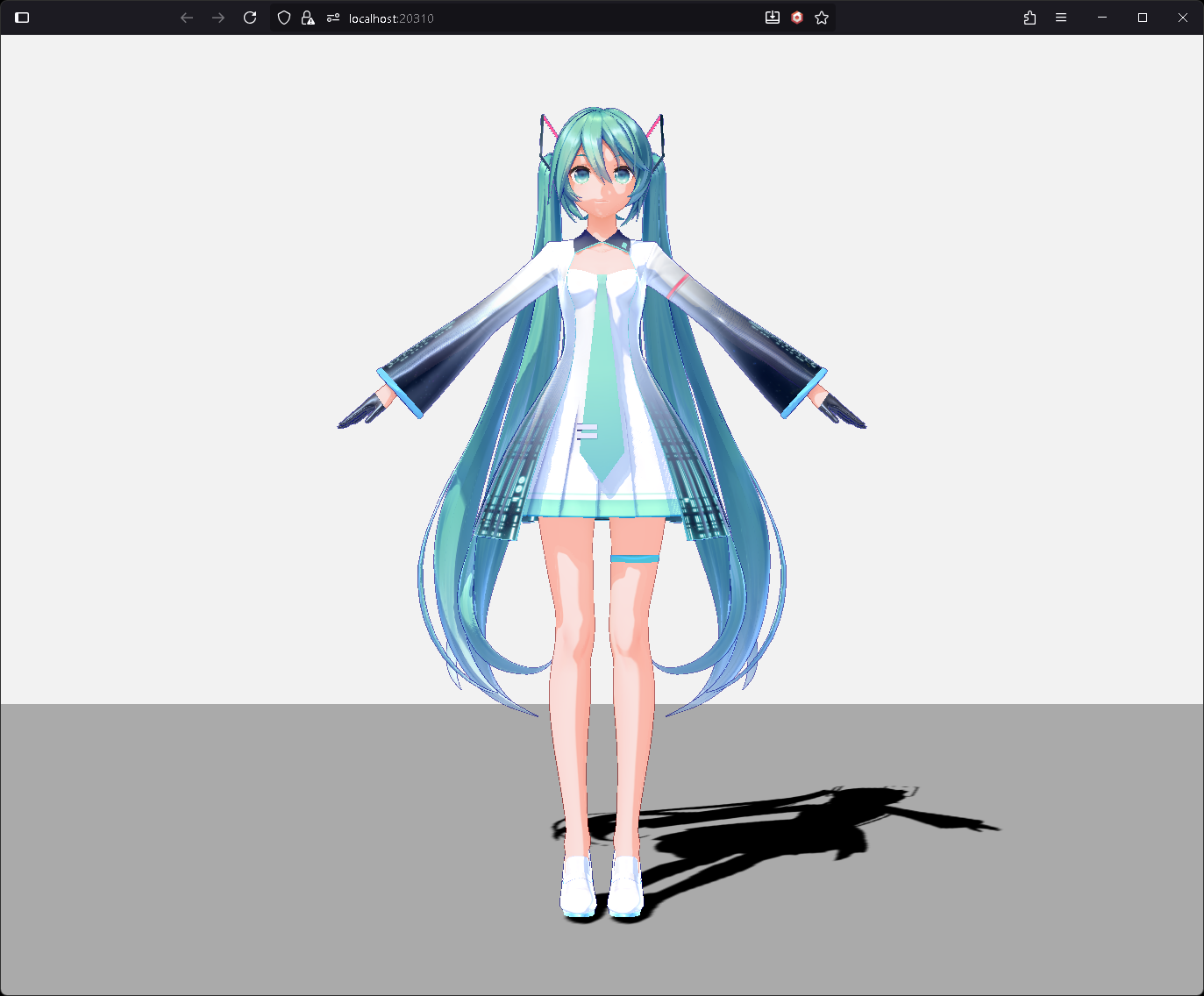Load MMD Model
Now we'll load an MMD model into the Scene and add shadows.
Download PMX Model
First, we need a PMX model to load.
This example uses the YYB Hatsune Miku 10th Anniversary model.
Download the model, extract it, and place it in the res/private_test/model/ folder.

Model folder structure example
Import Required Side-Effects
First, import the side-effects needed to load the model.
//...
import "babylon-mmd/esm/Loader/pmxLoader";
import "babylon-mmd/esm/Loader/mmdOutlineRenderer";
//...
babylon-mmd extends Babylon.js's SceneLoader to enable loading PMX/PMD models.
To load PMD models, import babylon-mmd/esm/Loader/pmdLoader and use the same method as loading PMX models described below.
mmdOutlineRenderer provides functionality to draw outlines for MMD models. If outline rendering is not needed, you don't need to import it.
Load PMX Model
Use the LoadAssetContainerAsync function to load the model. You can specify the mmdmodel option in pluginOptions to pass necessary settings to the MMD model loader.
//...
import { LoadAssetContainerAsync } from "@babylonjs/core/Loading/sceneLoader";
//...
import { MmdStandardMaterialBuilder } from "babylon-mmd/esm/Loader/mmdStandardMaterialBuilder";
//...
import type { MmdMesh } from "babylon-mmd/esm/Runtime/mmdMesh";
//...
export class SceneBuilder implements ISceneBuilder {
public async build(_canvas: HTMLCanvasElement, engine: AbstractEngine): Promise<Scene> {
const materialBuilder = new MmdStandardMaterialBuilder();
const scene = new Scene(engine);
// ...
const modelMesh = await LoadAssetContainerAsync(
"res/private_test/model/YYB Hatsune Miku_10th/YYB Hatsune Miku_10th_v1.02.pmx",
scene,
{
pluginOptions: {
mmdmodel: {
loggingEnabled: true,
materialBuilder: materialBuilder
}
}
}).then(result => {
result.addAllToScene();
return result.rootNodes[0] as MmdMesh;
});
return scene;
}
}
The settings passed to the pluginOptions.mmdmodel option when loading the model are as follows:
loggingEnabled: Whether to output logs during the loading process. Useful for debugging.materialBuilder: Specifies the implementation for creating MMD model materials.MmdStandardMaterialBuilderis the default implementation for creating basic MMD materials. If you want to use custom materials, you can implement theIMmdMaterialBuilderinterface and pass it.
When the model is loaded, an AssetContainer is returned. Call the addAllToScene method to add the model to the scene.
The model's root node can be accessed as the first element of the rootNodes array. For MMD models, the first root node always satisfies MmdMesh.
Add Shadows to Model
To add shadows to the model, add the model to the ShadowGenerator we created earlier.
//...
export class SceneBuilder implements ISceneBuilder {
public async build(_canvas: HTMLCanvasElement, engine: AbstractEngine): Promise<Scene> {
//...
for (const mesh of modelMesh.metadata.meshes) mesh.receiveShadows = true;
shadowGenerator.addShadowCaster(modelMesh);
return scene;
}
}
//...
MMD models consist of multiple meshes divided by material. Therefore, we iterate through the modelMesh.metadata.meshes array and configure each mesh to receive shadows.
Result
Now when you check the browser, you can see that the model has been loaded.

Full code
import "@babylonjs/core/Lights/Shadows/shadowGeneratorSceneComponent";
import "babylon-mmd/esm/Loader/pmxLoader";
import "babylon-mmd/esm/Loader/mmdOutlineRenderer";
import type { AbstractEngine } from "@babylonjs/core/Engines/abstractEngine";
import { DirectionalLight } from "@babylonjs/core/Lights/directionalLight";
import { ShadowGenerator } from "@babylonjs/core/Lights/Shadows/shadowGenerator";
import { LoadAssetContainerAsync } from "@babylonjs/core/Loading/sceneLoader";
import { Color3, Color4 } from "@babylonjs/core/Maths/math.color";
import { Vector3 } from "@babylonjs/core/Maths/math.vector";
import { CreateGround } from "@babylonjs/core/Meshes/Builders/groundBuilder";
import { Scene } from "@babylonjs/core/scene";
import { MmdStandardMaterialBuilder } from "babylon-mmd/esm/Loader/mmdStandardMaterialBuilder";
import { MmdCamera } from "babylon-mmd/esm/Runtime/mmdCamera";
import type { MmdMesh } from "babylon-mmd/esm/Runtime/mmdMesh";
import type { ISceneBuilder } from "./baseRuntime";
export class SceneBuilder implements ISceneBuilder {
public async build(_canvas: HTMLCanvasElement, engine: AbstractEngine): Promise<Scene> {
const materialBuilder = new MmdStandardMaterialBuilder();
const scene = new Scene(engine);
scene.clearColor = new Color4(0.95, 0.95, 0.95, 1.0);
scene.ambientColor = new Color3(0.5, 0.5, 0.5);
const mmdCamera = new MmdCamera("MmdCamera", new Vector3(0, 10, 0), scene);
const directionalLight = new DirectionalLight("DirectionalLight", new Vector3(0.5, -1, 1), scene);
directionalLight.intensity = 1.0;
directionalLight.autoCalcShadowZBounds = true;
const shadowGenerator = new ShadowGenerator(1024, directionalLight, true);
shadowGenerator.transparencyShadow = true;
shadowGenerator.usePercentageCloserFiltering = true;
shadowGenerator.forceBackFacesOnly = true;
shadowGenerator.filteringQuality = ShadowGenerator.QUALITY_MEDIUM;
shadowGenerator.frustumEdgeFalloff = 0.1;
const ground = CreateGround("ground1", { width: 100, height: 100, subdivisions: 2, updatable: false }, scene);
ground.receiveShadows = true;
const modelMesh = await LoadAssetContainerAsync(
"res/private_test/model/YYB Hatsune Miku_10th/YYB Hatsune Miku_10th_v1.02.pmx",
scene,
{
pluginOptions: {
mmdmodel: {
loggingEnabled: true,
materialBuilder: materialBuilder
}
}
}).then(result => {
result.addAllToScene();
return result.rootNodes[0] as MmdMesh;
});
for (const mesh of modelMesh.metadata.meshes) mesh.receiveShadows = true;
shadowGenerator.addShadowCaster(modelMesh);
return scene;
}
}